
Bolton Hill is a neighborhood in Baltimore, Maryland, with 20 blocks of mostly preserved buildings from the late 19th century. It is listed on the National Register of Historic Places, preserved as a Baltimore City Historic District, and included within the boundaries of Baltimore National Heritage Area. The neighborhood is bounded by North Avenue, Mount Royal Avenue, Cathedral Street, Dolphin Street, and Eutaw Place. Bolton Hill is a largely residential neighborhood with three-story row houses with red brick, white marble steps, and high ceilings. There are also larger more ornate originally single-family houses, many houses of worship, parks, monuments, and a few large apartment buildings. Many significant residents have lived in the neighborhood, including F. Scott Fitzgerald, Woodrow Wilson, the Cone sisters, and Florence Rena Sabin.
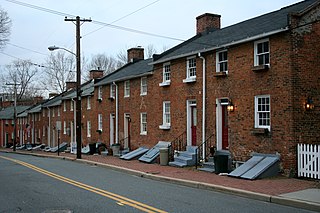
Oella is a mill town on the Patapsco River in western Baltimore County, Maryland, United States, located between Catonsville and Ellicott City. It is a 19th-century village of millworkers' homes.

The Craighill Channel Upper Range Rear Light is one of a pair of range lights that marks the second section of the shipping channel into Baltimore harbor.

The Craighill Channel Upper Range Front Light is one of a pair of range lights that marks the second section of the shipping channel into Baltimore harbor.

Seton Hill Historic District is a historic district in Baltimore, Maryland. It was listed on the National Register of Historic Places in 1975.
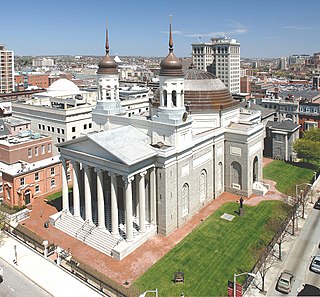
The Cathedral Hill Historic District is an area in Baltimore, Maryland. It lies in the northern part of Downtown just south of Mount Vernon. Roughly bounded by Saratoga Street, Park Avenue, Hamilton Street, and St. Paul Street, these 10 or so blocks contain some of the most significant buildings in Baltimore. The area takes its name from the Basilica of the Assumption which sits in the heart of the district. Despite the number of large religious structures in the area, the district's buildings are primarily commercial in character, with a broad collection of significant commercial structures ranging in date from 1790 to 1940.

Calvert Hills Historic District is a national historic district in College Park, Prince George's County, Maryland. It is roughly bounded on the north by Calvert Road, on the east by the Green Line metrorail corridor, on the south by the northern boundary of Riverdale Park, and on the west by Baltimore Avenue. It does not include Calvert Park on the southeast corner. Primarily a middle-class single-family residential neighborhood, it also includes some apartment houses as well as the College Park Post Office, a contributing property at 4815 Calvert Road.

Troy, also known as Troy Hill Farm, is a historic slave plantation home located at Elkridge, Howard County, Maryland, United States. It is associated with the prominent Dorsey family of Howard County, who also built Dorsey Hall.

The Lawyers Hill Historic District is a national historic district located at Elkridge, Howard County, Maryland. The district encompasses a broad array of architectural styles ranging from 1738 Georgian Colonial to 1941 Georgian Revival. The collection of Victorian domestic architecture built during the 1840s to 1880s is unparalleled in the county, with no two houses the same. Some of the later cottages were designed by Philadelphia architect Brognard Okie. There are variations of the American Gothic Revival form, Italianate, Queen Anne, and Shingle-style structures. There is also a range of Colonial Revival houses, from craftsman era rustic cottages to more formal Georgian, and mass-produced Dutch Colonial models from the early 20th century.

Turkey Hill is a historic home at Linthicum Heights, Anne Arundel County, Maryland, United States. It was built about 1822 by William Linthicum. Originally the house consisted of a 1+1⁄2-story frame section and a three-story field stone section linked together by an open porch. As the family increased in size, Linthicum added another story to the frame portion, making it two and a half stories high. Also on the property is a birdhouse, modeled after Camden Station in Baltimore City; a late-19th-century carriage house; a late-19th-century meathouse; and an early-20th-century garage also stand on the property.
Beverly is a historic home located in Pocomoke City, Worcester County, Maryland, United States. It is a 2+1⁄2-story, Georgian-style Flemish bond brick house built about 1770. The house faces the Pocomoke River. An original circular ice house survives on the property.

The Bare Hills House is a historic home built about 1856 in the Mount Washington area of Baltimore County, Maryland, United States. It is a two-story frame dwelling with steep gables and board-and batten siding. The house is an example of the Carpenter Gothic style of architecture.

Brooklandville House, or the Valley Inn, is a historic restaurant and tavern building, and a former inn, located in Brooklandville, Baltimore County, Maryland. It is a 2+1⁄2-story stone structure facing the former railroad and dating from about 1832. It is associated with the Baltimore and Susquehanna Railroad, which crossed the property just to the south.
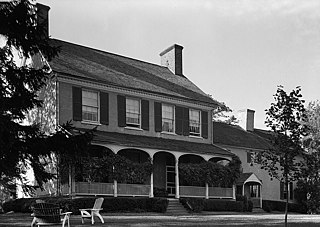
Prospect Hill is a historic home located at Long Green, Baltimore County, Maryland, United States. It was designed by architect William Thornton and built between 1796 and 1798. It is a 2+1⁄2-story Federal style brick house.

Knoxville is an unincorporated community in Frederick and Washington counties, Maryland, United States. The Robert Clagett Farm and Magnolia Plantation are listed on the National Register of Historic Places.

Brick Hill is a national historic district in Baltimore, Maryland, United States. It is a small, isolated enclave neighborhood of 2- and 2+1⁄2-story masonry duplexes constructed about 1877 to house workers in the nearby Meadow Mill of the Woodberry Manufacturing Company. All but one of the eleven duplexes are constructed of brick, hence the four-acre enclave's traditional name; the other dwelling is built of stone. Two small two-story frame houses are also included in the district.

Stone Hill Historic District is a national historic district in Baltimore, Maryland, United States. It is one of the original mill villages along the Jones Falls, having been developed circa 1845–1847 to house textile mill workers. Comprising seven blocks, the district includes 21 granite duplexes, a granite Superintendent's House, and a granite service building – all owned by Mount Vernon Mills from 1845 to 1925.
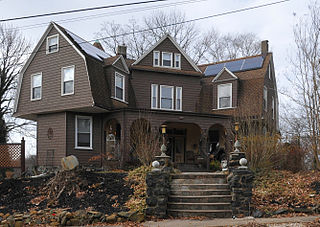
Windsor Hills Historic District is a national historic district in Baltimore, Maryland, United States. It is a cohesive residential suburb defined by rolling topography, winding, picturesque streets, stone garden walls, walks and private alley ways, early-20th century garden apartments, duplexes, and freestanding residences. Structures are predominantly of frame construction with locally quarried stone foundations. Windsor Hills developed over a period from about 1895 through 1929. The dominant styles include Shingle cottages, Dutch Colonial Revival houses, Foursquares, and Craftsman Bungalows.
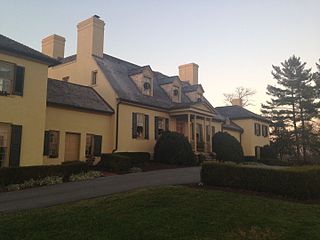
The Belmont Estate, now Belmont Manor and Historic Park, is a former forced-labor farm located at Elkridge, Howard County, Maryland, United States. Founded in the 1730s and known in the Colonial period as "Moore's Morning Choice", it was one of the earliest forced-labor farms in Howard County, Maryland. Its 1738 plantation house is one of the finest examples of Colonial Georgian architectural style in Maryland.

The Bare Hills Historic District encompasses a residential area north of Baltimore, Maryland, in Baltimore County, which had industrial beginnings before being transformed into a suburb of the city. The district includes Lake Roland Park as well as a cluster of largely vernacular dwellings between the park and Falls Turnpike that was built mainly in the 19th century.






















